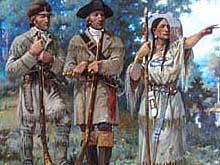
From the painting "Lewis and Clark at Three Forks" by Edgar S. Paxson. Courtesy of the Montana Historical Society. Image is digitally color-adjusted and cropped to fit page design. Click image for a more complete view of the entire painting.
The Lewis and Clark Legacy
Robert Steelquist, Education Coordinator
NOAA, Olympic Coast National Marine Sanctuary
In 1787, a book, Notes on the State of Virginia, was published as the first treatise for the general public on natural history on the North American continent. Its author was America’s most learned citizen-scientist, Thomas Jefferson. In Notes… Jefferson catalogued the frontier of a new landscape, and its natural lifeforms, its climate, geology, scenic and scientific wonders. But Jefferson’s curiosity extended past Virginia, over the Blue Ridge, beyond the Ohio River and eventually to the mountains of the West and the far Pacific Ocean. Unable to explore the uncharted western lands himself, he commissioned a "corps of discovery," and launched them on a journey to gather scientific facts and report back to him.
The 1803 to 1806 journey of Meriwether Lewis and William Clark represented the most ambitious exploration venture that the new nation had ever sponsored. In the name of the American people, a small cadre of skilled woodsmen, led by two Army captains and a Shoshone woman guide, traversed the continent and stopped at the Pacific Ocean. They wintered at Fort Clatsop, on a small tributary of the great Columbia River estuary, and explored the nearby coastal areas of today’s Oregon and Washington.
The information legacy of the Lewis and Clark expedition was profound. They charted vast areas of the Great Plains, Rocky Mountains and Columbia River watershed. Their ethnography, zoology and botany contributed greatly to the scientific literature. Most importantly, the spirit of that exploration led to a new appreciation of the natural wonders of North America and the potential for a nation that could grow to fill it.
Lewis and Clark stopped at the Pacific only because they didn’t possess the technology to go farther. Satisfied that they had completed Jefferson’s charge to them, they turned landward, retracing their steps (and exploring alternate eastward routes) to return to the familiar territories of the United States.
Today, nearly 200 years after Lewis and Clark faced the broad Pacific from the mouth of the Columbia, new technologies enable us to continue their journey of exploration. With the same boldness and curiosity, a new corps of discovery will descend into the Astoria Canyon to explore and catalogue its natural marvels. A host of cooperating organizations are continuing the saga of Lewis and Clark. They extend the dream and vision of Thomas Jefferson across time and into ocean realms even he couldn’t imagine. Embodied in the Lewis and Clark Legacy is Jefferson’s quest to seek and to understand the world of which we are such a part.
(top)
Sign up for the Ocean Explorer E-mail Update List.





























